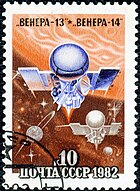Our website is made possible by displaying online advertisements to our visitors.
Please consider supporting us by disabling your ad blocker.
Venera 13
 Postage stamp of Venera 13/14 | |
| Mission type | Venus flyby / lander |
|---|---|
| Operator | Soviet Academy of Sciences |
| COSPAR ID | 1981-106A 1981-106D |
| SATCAT no. | 12927 15599 |
| Mission duration | Travel: 4 months, 2 days Lander: 127 minutes |
| Spacecraft properties | |
| Spacecraft type | 4V-1 no.760 |
| Manufacturer | NPO Lavochkin |
| Launch mass | 4,397.8 kilograms (9,695 lb)[1] |
| Landing mass | 760 kg (1,680 lb) |
| Dry mass | 1,643.72 kg (3,623.8 lb) |
| Dimensions | 2.7 m × 2.3 m × 2.7 m (8.9 ft × 7.5 ft × 8.9 ft) |
| Start of mission | |
| Launch date | October 30, 1981, 06:04:00 UTC[1] |
| Rocket | Proton-K/D-1 8K82K |
| Launch site | Baikonur 200/40 |
| End of mission | |
| Last contact | lander: March 1, 1982 / carrier: at least until April 25, 1983 |
| Orbital parameters | |
| Reference system | Heliocentric |
| Eccentricity | 0.17 |
| Perihelion altitude | 0.70 AU |
| Aphelion altitude | 0.99 AU |
| Inclination | 2.3 degrees |
| Period | 285 days |
| Flyby of Venus | |
| Spacecraft component | Venera 13 flight platform |
| Closest approach | March 1, 1982 |
| Distance | ~36,000 kilometres (22,000 mi) |
| Venus lander | |
| Spacecraft component | Venera 13 descent craft |
| Landing date | 03:57:21, March 1, 1982 |
| Landing site | 7°30′S 303°00′E / 7.5°S 303°E (east of Phoebe Regio) |
Venera 13 (Russian: Венера-13 'Venus 13') was part of the Soviet Venera program meant to explore Venus.
Venera 13 and 14 were identical spacecraft built to take advantage of the 1981 Venus launch opportunity. The probes were launched five days apart, with Venera 13 launching on 30 October 1981 at 06:04 UTC and Venera 14 launching on 4 November 1981 at 05:31 UTC. Both had an on-orbit dry mass of 760 kg.
Venera 13 transmitted the first recording of sounds from another planet, including sounds of Venusian wind, the lander hitting the ground, pyrotechnic lens cap removal and its impact on regolith, and action of the regolith drilling apparatus.
The descent lasted for about an hour.[2] Venera 13 landed at 03:57:21 UT at 7.5 S, 303 E, just east of the eastern extension of an elevated region known as Phoebe Regio. The area is composed of bedrock outcrops surrounded by dark, fine-grained soil.
- ^ a b Siddiqi, Asif (2018). Beyond Earth: A Chronicle of Deep Space Exploration, 1958–2016 (PDF) (second ed.). NASA History Program Office.
- ^ "NASA Space Science Data Coordinated Archive". Venera 13 Descent Craft. Retrieved 2024-10-23 – via www.donaldedavis.com.
Previous Page Next Page


